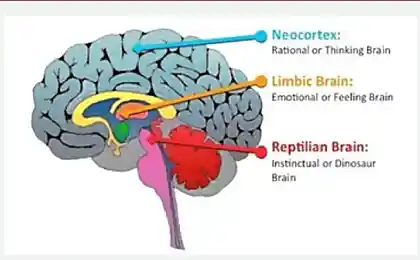594
Neurobiology of violence: how does the brain of the perpetrator

In the last 20 years neuroscientists and psychologists from different countries have conducted many studies that prove the propensity for violence is largely determined by the disturbances in the brain. However, scientists believe that a biological predisposition is not destiny, and the state of the nervous tissue can change — if you know what the problem is. Serial murder and the reduction of prefrontal lobes of the cortexWhich mental disorders can be the basis for wanting to cause fatal harm to another person? A clear answer to this question is not there — including the fact that it is very difficult to collect experimental group consisting solely of serial killers.
However, today we know that it is often a "criminal way" manifests itself, for example, dissimulee personality disorder. In the International classification of diseases (ICD-10) among its symptoms mentioned disregard for social norms, and indifference to others, and the behavior of "difficult to change on the basis of experience (even including penalties)". "Patients can not tolerate failure and easy aggression, including violence — added to the drafters of the ICD-10. — They tend to blame others or give plausible explanations for their behavior that lead them to conflict with society."
DSM-IV (the American manual for diagnosis and statistics of mental disorders) classifies dissimulee disorder to the so-called cluster B (of a theatrical, emotional, or fluctuating disorder), with narcissistic, hysterical and borderline personality disorders People who suffer from pathologies of this section, may differ a great charisma and lack of empathy, to show a tendency to manipulation and intimidation. However, you need to remember that not all people with personality disorders are prone to violence.

According to research psychologist from new York University Michael F. Lorber, people suffering from personality disorders, including dissocial disorder demonstrate reduced heart rate and a weak galvanic skin response — a measure of electrical conductivity of the skin. In addition, a psychologist at the University of Pennsylvania Adrian Rainey and a group of researchers from the University of southern California (USA) found out that at the physiological level in the brain of patients with personality disorders differs markedly from the brains of people with a healthy psyche: for example, they have less gray matter in the prefrontal lobes of the cerebral cortex, and the hippocampus is asymmetrical. A colleague of Rainey from the Royal College of psychiatrists (UK) James Blair also found that for patients with personality disorders characteristic pathological changes in the tonsils that are part of the limbic system responsible for the survival reactions and emotions. Always the mass murder lies the personality disorder? This question, of course, no clear answer. And yet scientists are confident that if you study the brain tissue in the case of such offender, with a high share of probability it is possible to detect these deviations.
Borderline personality disorder, which also belongs to the cluster B, may also serve — though not necessarily — the basis for illegal actions. Characterized by emotional instability, anxiety, and psychotic States. As found by the Professor of psychiatry of the University of Arizona Andrew E. Skodol, people suffering from borderline disorder can suddenly fall into a paranoid suspiciousness and impulsive aggression. The goal of aggressive behavior in this case may be more or less rational (for example, to call someone to order), but the actions are more rigid than necessary. As writes the American psychologist Leonard Berkowitz in his book "Aggression: causes, consequences and control," quoting a detective from Dallas: "Murders happen because people don't think... Leaped blood. A fight ensued, and now someone stabbed to death or shot." From a physiological point of view, impulsive aggression is associated with low levels of serotonin — one of the major neurotransmitters, the so-called "happiness hormone".
Specialist, National Institute of psychiatry Mexico's Ramon de La Fuente also found that in borderline disorder is changing your metabolism in the anterior cingulate cortex, which is involved in the execution of cognitive functions: reward anticipation, decision-making, empathy, managing impulsive reactions and are assumed to regulate blood pressure and heart rate (and here again we can recall the study of Lorber). Colleagues de La Fuente, scientists from Harvard medical school found that the prefrontal cortex is also suffering in borderline disorder, but she is also actively involved in the decision-making process and the handling of emotions.

Renowned psychiatrist, Professor at the University of Cambridge (UK) Simon Baron-Cohen has included borderline disorder to the list of pathologies that lead to so-called "zero degrees of empathy" when a person is unable to understand and take into account the feelings of others. Arguments about the percentage of serial killers suffers from a borderline, of course, be unfounded, but if all the factors: emotional instability, zero empathy, and impulsive aggression — agree on one point in time, the probability to cause harm to other people for a person, of course, will increase.
For one, cluster B, narcissistic personality disorder, according to Baron-Cohen, is also characterized by "zero degrees of empathy". This means that in this case must be present disorders in the limbic system and prefrontal lobes of the cortex. This makes a narcissistic disorder similar to dissimulee and border. However, psychotic symptoms in this case do not exist (and this distinguishes narcissism from a borderline). But with dissocial disorder it easier to mix as narcissistic behavior can be inclined and people with dissocial diagnosis.
Recidivism and low activity of the anterior cingulate cortexStudy, conducted in the laboratory of the Mind Research Network in Albuquerque (Mexico), showed that brain scans helps to assess the likelihood of recurrence after the committed crime the person was released from prison. Scientists came to such conclusion, having studied the work of the anterior cingulate cortex — the same region, which was studied by Ramon de La Fuente. In their experiment voluntarily participated 96 adult ex-offenders aged 20 to 52 years. Experts observed their behavior for four years after the end of the term of imprisonment. The study participants underwent a series of tests, during which scientists watched their brain using MRI. They noticed that people with low activity in the anterior cingulate cortex are twice as likely to break the law again, than people with a high level of activity in this area.
"MRI gives the opportunity to see that this part of the brain is not working properly — so that you can assess who is more inclined to impulsive antisocial behavior, leading to repeated arrests," explained the study's lead author, Dr. Kent A. Kyle. In his work States that the functions of the anterior cingulate cortex "associated with error processing, conflict monitoring, response selection, and avoidance learning" (a form of learning in which a person learns a response that allows to avoid harmful or painful stimulus — approx. ed.). If this area is damaged, people "begin to show disinhibition and apathy, become aggressive." "Patients with damage to the anterior cingulate cortex can be classified as people with acquired psychopathological personality type," the scientists write. And yet, Dr. Kyle is confident that with the creation of drugs that increase the level of activity in this brain region, the problems of such patients can be solved.
Violence and the amygdalathe Amygdala or the amygdala — part of limbic system that is responsible for is necessary for survival reactions, and emotions — along with other areas of the brain. Tonsils are "working" with fear and aggression, helping us understand the threat and choose how we will react to being hit or run. The study, conducted by psychologists from the University of Pittsburgh (USA) showed that people prone to violence and aggression and have psychopathic behavioral traits, amygdala are smaller than normal: up to a third of normal volume. Another experiment, conducted in Alabama a & m University (USA), confirmed these findings and allowed us to establish that in the case when a man shows psychopathic behavioral traits, reduced not only the volume but also the health of the tonsils.

Another unusually long-term study, which, together with colleagues from Brooklyn College (USA) conducted the Pennsylvania psychologist Adrian Rainey (already mentioned in this material), has allowed to establish that the tonsils begin to function properly long before people for the first time demonstrates a propensity for violence. In the experiment, the team led by Rainey studied the behavior 1795 three-year-olds. They were asked to listen to two types of sounds: one followed a silence, and after another loud, obnoxious alarm. Some children reacted to him with fear, showing the so-called conditional reflex fading, for which the answer of the tonsils, and the other was not scary. For 20 years scientists watched the participants in this experiment and found that the crimes were mostly committed by those who are not frozen with fear during the first test operation of the tonsils.
If the "crime of reason" can be diagnosed, is it possible to change the crime or to his relapse? Scientists believe that, Yes. Andriano Rainey, for example, failed to detect that the special nutrition program and system of training and cognitive exercises for children used at the age of three, allows to increase the functionality of the brain and by the age of 23 to 34%, which is more than three times reduces the propensity for violence (compared to a control group that did not train and did not adhere to the nutrition program). Specialist from Colorado state University (USA) David olds, also found that if expectant mothers with low-income visit the nurses just talk to them about health, education and parenting in adolescence their children are less likely to arrest.

A simple program for work with prisoners also showed their effectiveness. Experts from Oxford University (UK) and the University of Nijmegen (the Netherlands), the study suggested that offenders who served their sentence in prison, 10-week program of yoga classes. As a result, the participants learned to better control their impulsivity. The same group of researchers conducted another study in another British prison, offering prisoners a course of vitamins, minerals and fatty acids. While some participants had received these drugs and others placebos.
The results showed that people from the first group began to attack inmates and insult them by 26.4% less than those who took the "fake" vitamins. Subsequently this figure rose to 35%, while the indicator remained stable. Later research in Dutch prisons is allowed to confirm these data. Now based on them Adrian Rainey is developing a course of vitamin and mineral supplements for children and adolescents prone to violence. "Biology is not destiny, says Rainey. — We can change the biological basis of crime and violence, and in this there is no doubt".published
P. S. And remember, just changing your mind — together we change the world! ©
Source: theoryandpractice.ru























